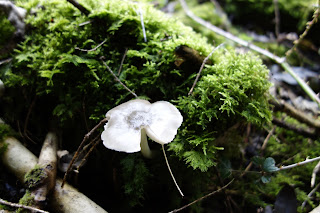The season is now, finally, getting going.
Focussing first on the bigger things, Sunday's foray provided my first real introduction to the Shields or Pluteus mushrooms. Peter Marren's Mushrooms book describes these as:
"Mostly smallish mushrooms characterised by round caps and gills that are pink and free (i.e. not attached to the stem). All of them grow on rotten wood, including woodchip and sawdust. Some have attractively patterned or brightly coloured caps. They may be indicators of ancient, or at least lightly managed, woodland."Taking these in the order we found them, which means starting with this terrible photo, we first came across this Pluteus with a mousy brown to greyish cap.
 |
| Pluteus pouzarianus |
We went on to see a pretty little yellow mushroom sprouting from one of the woodpiles which dotted the woodland floor - another Pluteus. There are a couple of species which can have a yellow cap so Nick took this one home for determination and found it to be Yellow Shield P. chrysophaeus.
 |
| Yellow Shield Pluteus crysophaeus. Image credit: Wu Di, Sussex Fungus Group |
Next up another mousy-brown Pluteus, this time growing on a pile of decaying logs from a broadleaf tree, which makes this a Deer Shield P. cervinus.
 |
| Deer Shield Pluteus cervinus |
 |
| Velvet Shield Pluteus umbrosus |
 |
| Willow Shield Pluteus salicinus |
But we did find some little charmers.
Burgundydrop Bonnet Mycena haemotopus (a relation of the Saffrondrop Bonnet M. crocata which I came across in The Mens the other day) was a new one for me.
 |
| Burgundydrop Bonnet Mycena haemotopus |
 |
| Burgundydrop Bonnet Mycena haemotopus |
Equally memorable, albeit for a different reason, was this Foetid Parachute Micromphale (=Marasmiellus) foetidum. It stank.
 |
| Foetid Parachute Micromphale (=Marasmiellus) foetidum |
 |
| Chaetosphaerella phaeostroma |
Nick Aplin identified this one as Chaetosphaerella phaeostroma. If you zoom in on the photo you can just make out the tiny spherical perithecia (fruiting bodies).
There was one species which got our group of foray-ers particularly interested...
Here you can see us all trying to get a look at Chlorencoelia versiformis.
 |
| Chlorencoelia versiformis |
According to the UK Biodiversity Action Plan this species is a very rare saprotroph (type of fungus that feeds on decaying organic matter) found on dead wood of broadleaved species.
For the record
Date: 2 October 2016
Location: Private site near Northchapel
All records to be submitted by Nick Aplin, Sussex Fungus Group

No comments:
Post a Comment